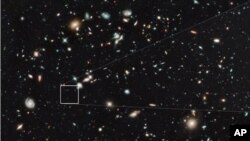Since 1990, the Hubble space telescope has served as a stunning observatory, sending hundreds of thousands of images of the universe back to Earth. The latest Hubble discovery - what scientists believe to be a tiny galaxy of blue stars that is perhaps the oldest object ever seen in the universe.
From its orbiting vantage point 568 kilometers above the Earth, NASA's Hubble telescope has forever altered the meaning of the phrase "as far as the eye can see."
Garth Illingworth, a professor of astronomy and astrophysics at the University of California, Santa Cruz, is Hubble's principal investigator. He says this telescopic eye has spotted what is likely the oldest and most distant object ever seen in the universe - a galaxy that dates back 13.2 billion years.
"We've gone back through 96 percent of the life of the universe to when the universe was only four percent of its current age, to 500 million years after the Big Bang," he said.
According to the Big Bang theory, the universe was born 13.7 billion years ago in a single violent event, and, since that time, galaxies outside our Milky Way have been speeding away from us, creating a rapidly expanding universe.
Speaking at a NASA teleconference Wednesday, Illingworth explained that scientists had pored through Hubble's observations and already discovered nearly 50 galaxies that date back to 650 million years after the formation of the universe.
That changed after Hubble got an upgraded camera in May 2009, which allowed scientists to look even deeper into space and further back in time.
That is when astronomers spotted what looked like a faint dot of starlight in the Hubble exposures.
"We managed eventually to find an object," Garth Illingworth said. "This galaxy [that formed] 500 million years after the Big Bang is extraordinarily faint, a very blue, dynamic object full of stars, forming star birth. There's a whole lot of stars being formed in the object."
Scientists involved in this Hubble discovery say they are about 80 percent confident that this object is a compact galaxy of blue stars, less than one percent of the size of our Milky Way. They say this object's light traveled 13.2 billion years to reach the lenses of the Hubble telescope.
Illingworth says that makes this object the most ancient thing ever seen in the 13.7-billion-year-old universe. And, according to Illingworth, this galactic finding has even greater implications.
"We were astonished to find that the star birth at 500 million years was dramatically less than it was at 650 million years," he said.
Using Hubble observations, astronomers estimate the rate of star birth in the universe increased ten-fold in the period between 500 million years and 650 million years after the Big Bang, a relatively short period of time in cosmic terms.
"So not only did this image tell us about or show us a glimpse of the galaxy at very early times, but it also told us about how the star birth was increasing in the universe," he said.
Illingworth says he believes Hubble will enable astronomers to find more 500-million-year-old galaxies, but he says it will take the next generation of telescope to see older objects and earlier times.
The findings are published in the January 27 issue of the journal Nature.
This video is a zoom into the Hubble Space Telescope infrared Ultra Deep Field, first taken in 2009. It is a very small patch of sky in the southern constellation Fornax. The zoom centers on the farthest identified object in the field. The object, possibly a galaxy, looks red because its light has been stretched by the expansion of the universe.
Credit: NASA/ESA/G. Bacon, STScI (no audio)











